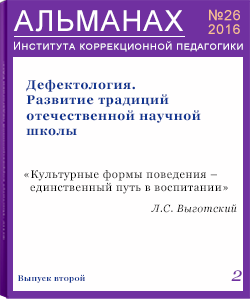Defectology. Development of the domestic scientific school's traditions
Almanac #26 · Issue #2 · 2016

Mother and a blind premature infant: interaction features
Keywords
Mother and a blind premature infant: interaction features
blind premature babiesretinopathy of prematurity
visual deprivation
spatial - temporal characteristics of interaction
communicative action
maintaining interaction
social deprivation
Communication phenomena of an infant with Down's syndrome
Keywords
Communication phenomena of an infant with Down's syndrome
Down's syndromecommunication of mother with her child
child communication phenomena
communication actions and communication actions' characteristics
communication development signs
signs of communication development abnormalities
communication need
limited communication need
early aid
overcoming the problems in the communication development between a mother and her child
Features of interaction in the "teacher - infant with Down's syndrome" dyad
Keywords
Features of interaction in the "teacher - infant with Down's syndrome" dyad
orphan infants with Down's syndrometeachers' ideas about their professional work and children with Down's syndrome
professional training of orphanage teachers
Developmental interaction: experience of work in an orphanage
Keywords
Developmental interaction: experience of work in an orphanage
orphan infants with organic lesion of the central nervous systemreasons of insufficient professional competence of teachers in specialized orphanage
experience in development of person-oriented interaction
Opportunities of music lessons in the special correctional work with children having complex development abnormalities
Keywords
Opportunities of music lessons in the special correctional work with children having complex development abnormalities
children with complex development abnormalitiesmusic lessons
neuropsychological approach
development of the sense of rhythm as a basis for improving the state of impressive and expressive speech
The teacher’s of the deaf work after cochlear implantation. Reorganization of the emotional interaction with a child on a normal sensory basis obtained by the child is a condition of the proc
Keywords
The teacher’s of the deaf work after cochlear implantation. Reorganization of the emotional interaction with a child on a normal sensory basis obtained by the child is a condition of the proc
rehabilitation of children with cochlear implantationcochlear implantation
teacher’s of the deaf work sessions
interaction of parents with her child with cochlear implantation
session completion indicators
emotional interaction
new sensory basis
Emotional and comprehension approach to correction of autism spectrum disorders
Keywords
Emotional and comprehension approach to correction of autism spectrum disorders
early infantile autismautism in childhood
mental development disturbance
emotional-and- comprehension approach as an aid to autistic children
Initial stage of psychological aid to an autistic child. Report 1. From stereotypic autostimulation to a joint play
Keywords
Initial stage of psychological aid to an autistic child. Report 1. From stereotypic autostimulation to a joint play
autismautistic spectrum disorders
autistic children
stereotypic autostimulation functions
use of stereotypic actions for establishing an emotional contact
understanding of stereotypic actions in a joint play